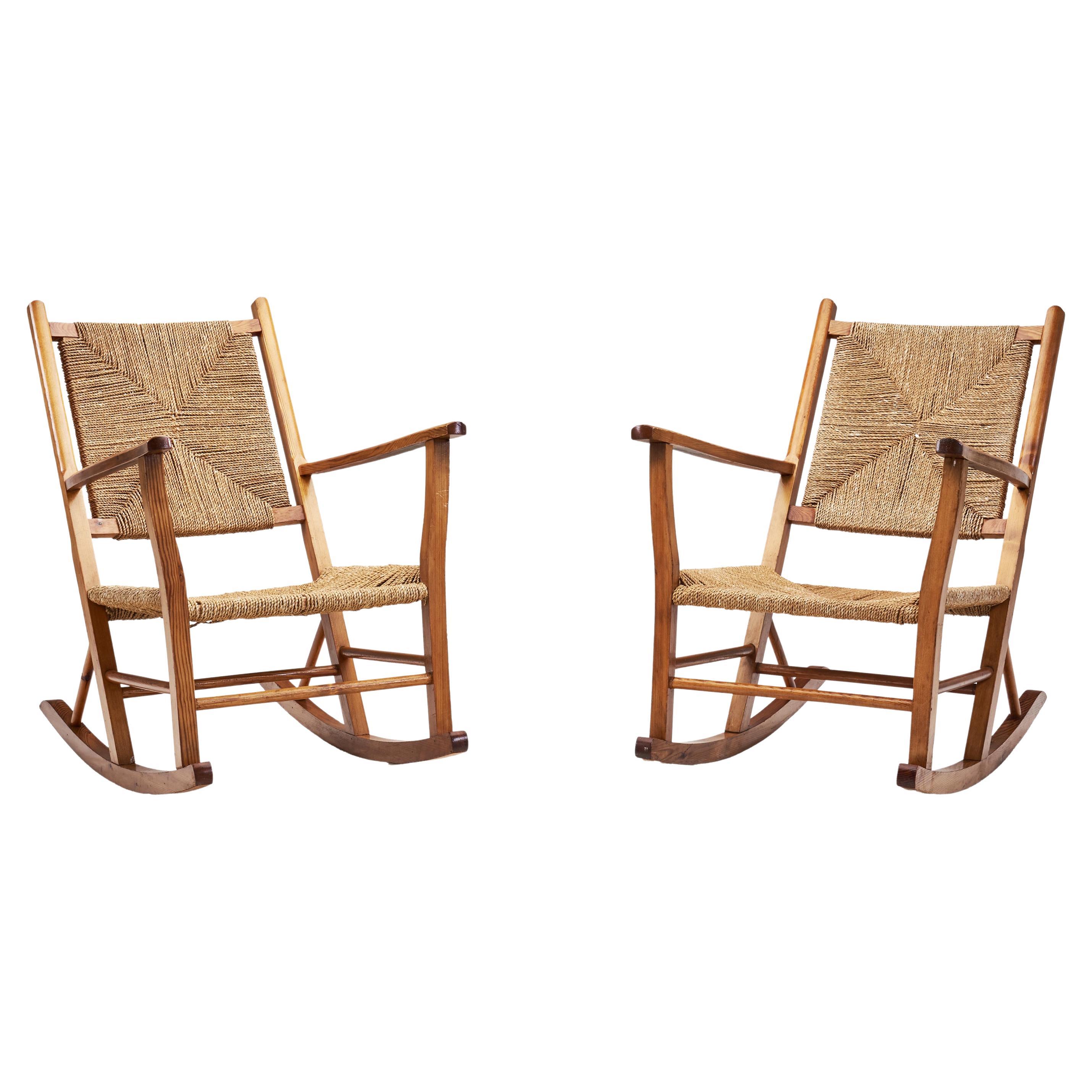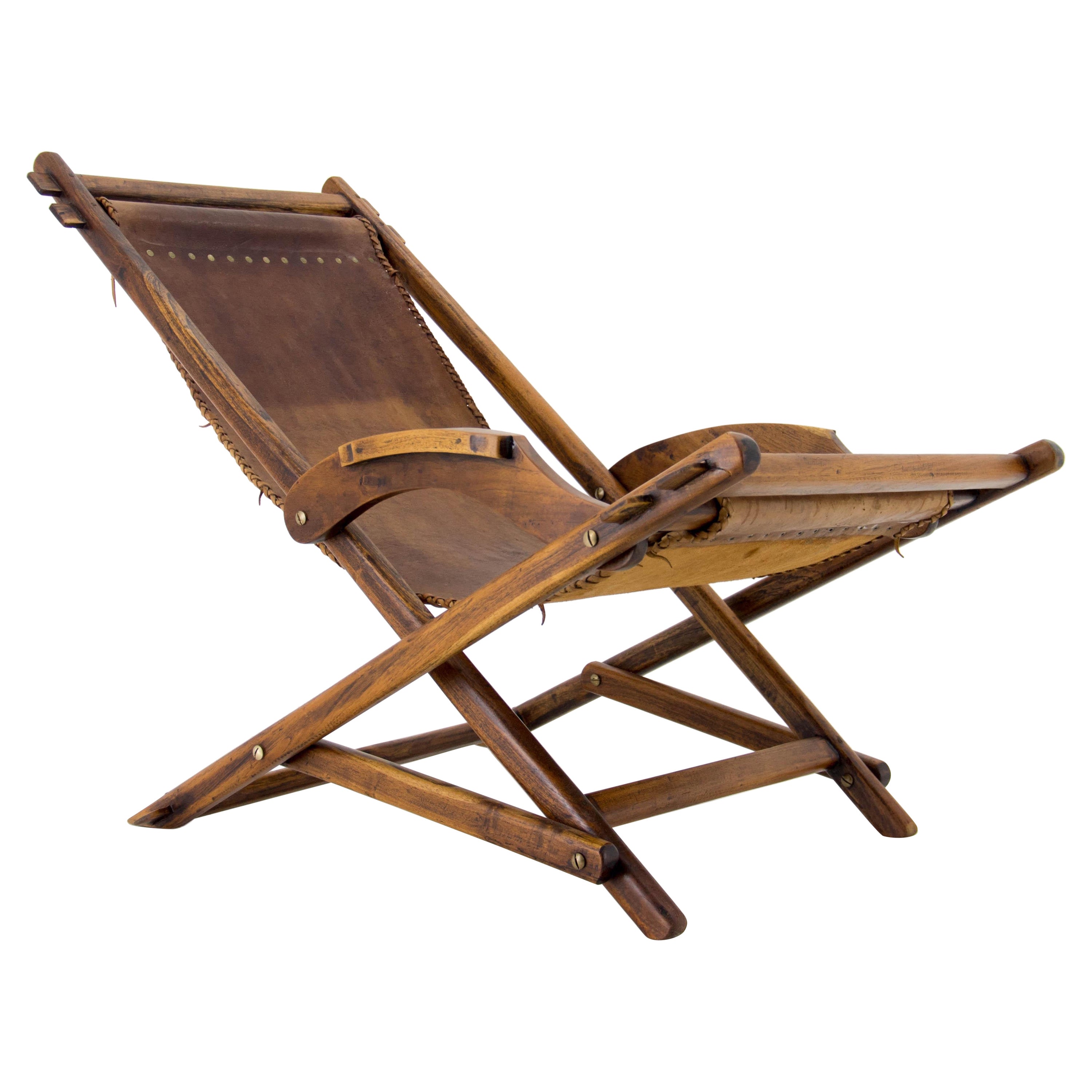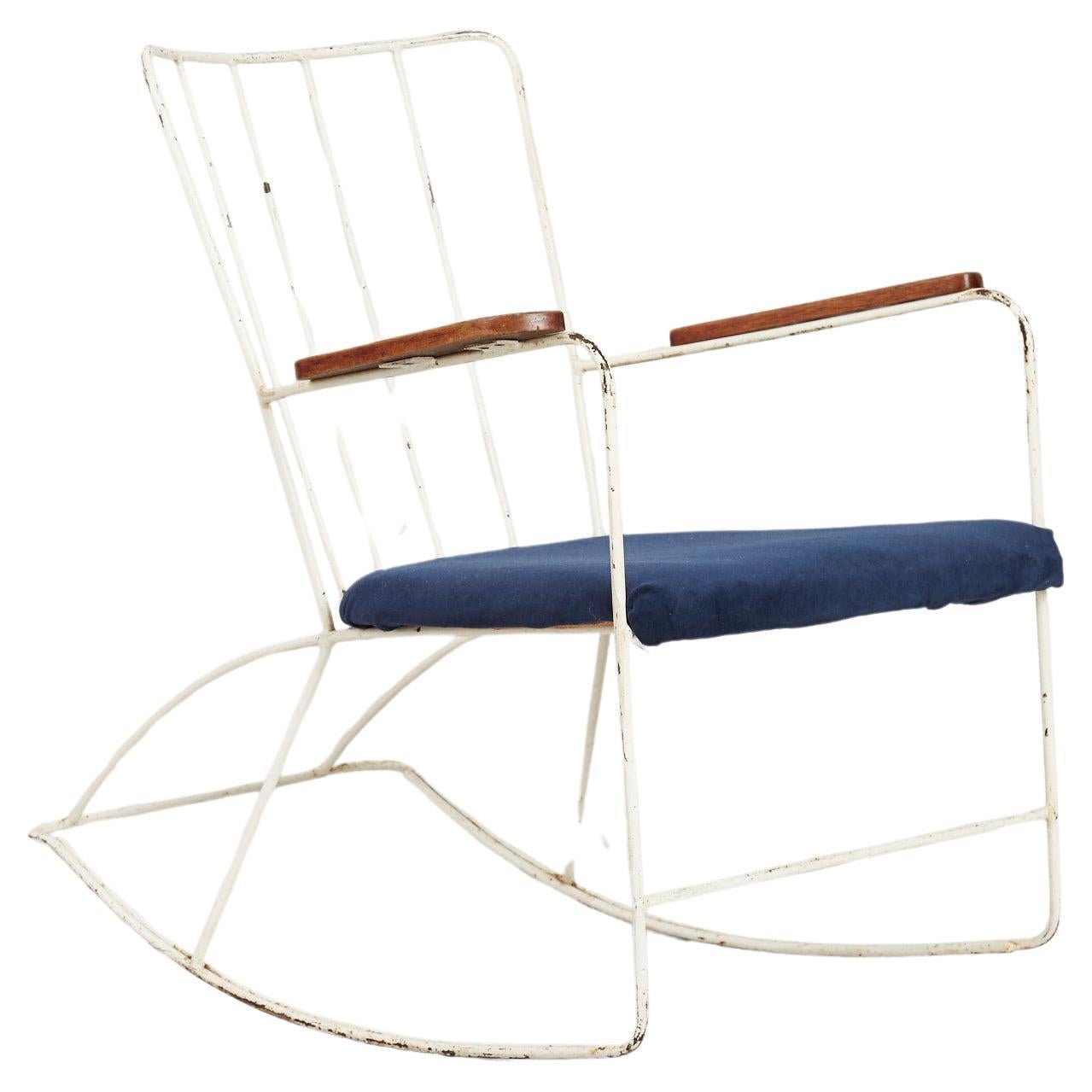Items Similar to Norwegian Wood and Papercord Rocking Chair by Slåke Møbelfabrik, Norway 1940s
Want more images or videos?
Request additional images or videos from the seller
1 of 19
Norwegian Wood and Papercord Rocking Chair by Slåke Møbelfabrik, Norway 1940s
About the Item
Slåke has produced furniture since 1938. The work has always been based on good craftsmanship and solid furniture traditions. Since the beginning, it has been important to the manufacturer that both function and form are taken care of. What they make “must be good to look at, touch, and sit on.”
With an elaborate structure, traditional technique and materials, this rocking chair can only be described as beautiful both in terms of aesthetic quality and craftsmanship. The solid wooden structure has the classic rocking chair look with additional elements supporting stability, including the box stretchers with interlocking joints and the supporters connecting the rockers to the elongated back legs. The latter ensures the strongly inclined position of the back. When thinking about heirloom quality furniture, the materials used are as essential as the design itself. One material that is often vastly underrated is papercord. Noteworthy for its durability, this material is also beloved for its functional and aesthetic qualities. The rocking chair has two woven panels of twisted papercord, one comprising the seat, and one the back. Since they are woven across an open wood frame, the panels are exceptionally comfortable, able to stretch slightly to accommodate the sitter. Papercord became perhaps the most distinctive and, for some people, the type of seat most closely associated with chairs from the Scandinavian mid-century modern period. As a rocking chair, this model has an equally arresting level of craftsmanship. The rocker rails have a smooth curve that stands out against the mostly straight lines. The wood’s rich colour complements the papercord well, and fits with almost any colour palette.
While they play a prominent role in both architecture and pop culture, rocking chairs solidified their place in Scandinavian design history as well. As this Norwegian model proves, functionality can manifest in many forms, but it is always accompanied by quality and a great aesthetic quality in Scandinavian design.
Condition:
In good vintage condition. Wear consistent with age and use. Some small scratches and marks on the wood.
Dimensions:
22.44 in W x 33.26 in D x 31.29 in H; Seat height 13.77 in; Arm height 24.4 in
57 cm W x 84.5 cm D x 79.5 cm H; Seat height 35 cm; Arm height 62 cm
- Dimensions:Height: 31.3 in (79.5 cm)Width: 22.45 in (57 cm)Depth: 33.27 in (84.5 cm)Seat Height: 13.78 in (35 cm)
- Style:Mid-Century Modern (Of the Period)
- Materials and Techniques:
- Place of Origin:
- Period:
- Date of Manufacture:1940s
- Condition:Wear consistent with age and use. Some small scratches and marks on the wood.
- Seller Location:Utrecht, NL
- Reference Number:
About the Seller
5.0
Recognized Seller
These prestigious sellers are industry leaders and represent the highest echelon for item quality and design.
Platinum Seller
These expertly vetted sellers are 1stDibs' most experienced sellers and are rated highest by our customers.
1stDibs seller since 2017
358 sales on 1stDibs
Typical response time: 2 hours
Associations
20th Century Specialists
- ShippingRetrieving quote...Ships From: Utrecht, Netherlands
- Return PolicyA return for this item may be initiated within 7 days of delivery.
More From This SellerView All
- Norwegian Wood and Papercord Rocking Chairs by Slåke Møbelfabrikk, Norway 1940sLocated in Utrecht, NLSlåke has produced furniture since 1938. The work has always been based on good craftsmanship and solid furniture traditions. Since the beginning, it has been important to the manufa...Category
Vintage 1940s Norwegian Scandinavian Modern Rocking Chairs
MaterialsPapercord, Wood
- AB Åby Möbelfabrik Pine Rocking Chair, Sweden 1940sLocated in Utrecht, NLWhile they play a prominent role in both architecture and pop culture, rocking chairs solidified their place in Scandinavian design history as well. As this Swedish model proves, functionality can manifest in many forms, but it is always accompanied by both great material and aesthetic quality in Swedish design. Taking influence from the golden age of modernism in Sweden and the 1930s’ cabin furniture, this rocking chair was made in the famous “sportstugemöbel” style, originally intended for Swedish summer houses. Solid pine was the preferred material in this specific style and some of the most prominent Swedish designers created models for these summer residencies, including Axel Einar Hjorth and Carl Malmsten. Functionality and longevity were the guiding principles for the style, and accordingly, for this rocking chair as well. The pine structure is very polished and firm, assembled with an expert joinery technique. The seat is ergonomically carved, and the edges are gently rounded for maximum comfort. Åby furniture...Category
Vintage 1940s Swedish Scandinavian Modern Rocking Chairs
MaterialsPine
- "Razorblade" Rocking Chair by Henning Kjærnulf for EG Møbler, Denmark 1960sBy Henning KjærnulfLocated in Utrecht, NLWhile they play a prominent role in both architecture and pop culture, rocking chairs solidified their place in Scandinavian design history as well. As this Henning Kjærnulf model pr...Category
Vintage 1960s Danish Scandinavian Modern Rocking Chairs
MaterialsFabric, Wood
- Scandinavian Brutalist Oak rocking Chair, Scandinavia 1970sLocated in Utrecht, NLWhile they play a prominent role in both architecture and pop culture, rocking chairs solidified their place in Scandinavian design history as well. As this model proves, functionality can manifest in many forms, but it is always accompanied by expert craftsmanship and a great aesthetic quality. The Brutalist style of design - the term derives from the French word brut, meaning “raw” – is characterized by a deliberate plainness and crudity, and emerged in the mid-20th century and gained popularity in the late 1950s and 1960s. In furniture and décor, the Brutalist movement was somber, giving importance to eerie organic and rugged shapes in earthy tones. The defining characteristics of Brutalist furniture design...Category
Vintage 1970s Scandinavian Scandinavian Modern Rocking Chairs
MaterialsOak
- Alfred Christensen Upholstered Armchair for Slagelse Møbelfabrik, Denmark 1940sBy Alfred ChristensenLocated in Utrecht, NLDanish Modern focused more on the aesthetics of modern design whilst employing the exquisite technique and material familiarity of highly skilled craftsmen known as cabinetmakers. Alfred Christensen’s present armchair in this style is a rare and exquisite example of this. Clean and pure lines define this armchair that are coupled with expert craftsmanship and delicate research into proportions, materials and the requirements of the human body, adapting design to modern-day needs. Adopting the trend of abandoning ornamentation to benefit the form, Christensen maintained the beauty and warmth inherent to traditional Danish cabinetmaking. In consequence, this armchair has a beautiful, warm look with rounded edges and an open look. The only ornamentation is the piping cord that runs along the edges of the body. The unique colour of the velour upholstery in combination with the dark, stained beech legs create warm elegance, perfect to bring a modern touch to any space. While Danish designers, including Alfred Christensen, had many principles, above all, all designers...Category
Mid-20th Century Danish Scandinavian Modern Armchairs
MaterialsFabric, Wood
- Wood Turned Chairs with Woven Rush Seats, Europe Ca 1940sLocated in Utrecht, NLMid-century designers were eager to break free from the aesthetics of the past and experiment with new forms, and techniques. At the same time, especially in Europe, the modernist design movement was often based on traditional styles and techniques, such as turned chairs. Turned chairs — sometimes called thrown chairs or spindle chairs — represent a style of Elizabethan or Jacobean turned furniture that had a vogue in the late 16th and early 17th century. The technique was carried on to the 20th century and was widespread in Europe as well, where craftsmen created durable pieces for various interiors and purposes. In turned furniture, the individual wooden spindles of the piece were made by shaping them with chisels and gouges while they were being spun, or turned between the centre points of a lathe. The construction of this pair is evocative of the more robust Arts and Crafts Movement, featuring subtle decorative elements such as the finials atop the backs. The sphere-shaped finials aren’t the only ornamentations on the design; the shape of the two splats on the back, the carved stretchers and carving on the feet are all decorative features that make this pair visually arresting. In later turned chairs, like this pair, rush seats were common. Here, the seats are woven around the frames with a light colour that beautifully contrasts to the dark, patinated wood. The partnership of the two natural materials is very effective as well; the wood and rush pair...Category
Vintage 1940s European Mid-Century Modern Chairs
MaterialsRush, Wood
You May Also Like
- Unique Rocking Chair, 1940sLocated in Praha, CZCustom hand made armchair with unique sophisticated rocking system. Made of elm and genuine leather in 1940s in Czechoslovakia. Very good condition.Category
Vintage 1940s Czech Mid-Century Modern Rocking Chairs
MaterialsLeather, Elm
- 1940s Swedish Rocking Chair by Gustaf Axel BergBy Gustaf Axel Berg, Alvar AaltoLocated in Shepperton, SurreyA particularly fine 1940s birch bentwood rocking chair by Swedish designer Gustaf Axel Berg. An early importer of Alvar Aalto furniture, Gustaf Berg's own designs were influenced ...Category
Mid-20th Century Swedish Mid-Century Modern Rocking Chairs
MaterialsBirch
- Ernest Race Rocking Chair, 1940s, EnglandBy Ernest RaceLocated in London, GBDesigned by Ernest Race in 1948. A very rare low volume original, it has become a highly recognised design classic. Constructed from bent steel rod, the chair is very comfortable. ...Category
Vintage 1940s British Mid-Century Modern Rocking Chairs
MaterialsSteel
- Swedish Rocking Chair in Pine, 1940sBy Axel Einar HjorthLocated in Karlstad, SESwedish rocking chair in pine, 1940s a stunning rocking chair in the style of Axel Einar Hjorth with beautiful lines, low profile and circular seat. Condition: Excellent restored con...Category
20th Century Swedish Mid-Century Modern Rocking Chairs
MaterialsPine
- ML-33 Rocking Chair by Hans Wegner, 1940sBy Hans J. WegnerLocated in Hamburg, PAA classic Hans Wegner ML-33 rocking chair in teak. Made for Michael Laursen circa 1940s. The chair has a stylized wooden frame featuring verticle slats. The upholstery is vintage and...Category
Vintage 1940s Danish Scandinavian Modern Rocking Chairs
MaterialsUpholstery, Teak
- Göran Malmvall, Rocking Chair, Sweden, 1940sBy Goran MalmvallLocated in Stockholm, SERocking chair designed by Göran Malmvall, Svensk fur/Swedish pine for Karl Andersson & Söner. Made in the 1940s. Thus style of pine furniture were d...Category
Vintage 1940s European Scandinavian Modern Rocking Chairs
MaterialsPine
Recently Viewed
View AllMore Ways To Browse
Stendig Rocker
Ib Kofod Larsen Rocker
Wool Rocker
Hans J Wegner Bar
Matheson Chairs
Rocker Covers
Harden Mission
Eames Herman Miller Fiberglass Rar
Harden Rocker
Josef Hoffmann 267
Late 20th Century Wool Rocking Chairs
North American Stainless Steel Rocking Chairs
Oslo Sideboard
Vintage Hitchcock Rocking Chair
Antique Parlor Rocking Chair
Contemporary Birch Rocking Chairs
Contour Rocking Chair Vladimir
Eames Baby Rocker





